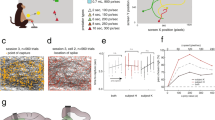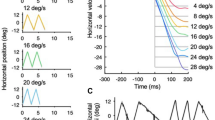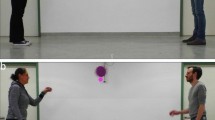Abstract
It remains unclear whether and, if so, how nonhuman animals make on-the-fly predictions during pursuit. Here we used a novel laboratory pursuit task that incentivizes the prediction of future prey positions. We trained three macaques to perform a joystick-controlled pursuit task in which prey follow intelligent escape algorithms. Subjects aimed toward the likely future positions of the prey, which indicated that they generate internal predictions and use these to guide behavior. We then developed a generative model that explains real-time pursuit trajectories and showed that our subjects use prey position, velocity and acceleration to make predictions. We identified neurons in the dorsal anterior cingulate cortex whose responses track these three variables. These neurons multiplexed prediction-related variables with a distinct and explicit representation of the future position of the prey. Our results provide a clear demonstration that the brain can explicitly represent future predictions and highlight the critical role of anterior cingulate cortex for future-oriented cognition.
This is a preview of subscription content, access via your institution
Access options
Access Nature and 54 other Nature Portfolio journals
Get Nature+, our best-value online-access subscription
$29.99 / 30 days
cancel any time
Subscribe to this journal
Receive 12 print issues and online access
$209.00 per year
only $17.42 per issue
Buy this article
- Purchase on Springer Link
- Instant access to full article PDF
Prices may be subject to local taxes which are calculated during checkout






Similar content being viewed by others
Data availability
A portion of the data is available on Github (https://github.com/sbyoo/prospectpursuit/). Full data are available from the corresponding author upon reasonable request.
Code availability
Code is available at https://github.com/sbyoo/prospectpursuit/.
References
Stephens, D. W. & Krebs, J. R. Foraging Theory (Princeton Univ. Press, 1986).
Ydenberg, R. C. & Dill, L. M. The economics of fleeing from predator. Adv. Study Behav. 16, 229–249 (1986).
Broom, M. & Ruxton, G. D. Evolutionarily stable stealing: game theory applied to kleptoparasitism. Behav. Ecol. 9, 397–403 (1998).
Cooper, W. E. & Frederick, W. G. Optimal flight initiation distance. J. Theor. Biol. 244, 59–67 (2007).
Helfman, G. S. Threat-sensitive predator avoidance in damselfish–trumpetfish interactions. Behav. Ecol. 24, 47–58 (2010).
Fujioka, E., Aihara, I., Sumiya, M., Aihara, K. & Hiryu, S. Echolocating bats use future-target information for optimal foraging. Proc. Natl Acad. Sci. USA 113, 4848–4852 (2016).
Clayton, N. S., Bussey, T. J. & Dickinson, A. Opinion: can animals recall the past and plan for the future? Nat. Rev. Neurosci. 4, 685–691 (2003).
Kolling, N., Scholl, J., Chekroud, A., Trier, H. A. & Rushworth, M. F. S. Prospection, perseverance, and insight in sequential behavior. Neuron 99, 1069–1082.e7 (2018).
Merchant, H. & Georgopoulos, A. P. Neurophysiology of perceptual and motor aspects of interception. J. Neurophysiol. 95, 1–13 (2006).
Seligman, M. E. P., Railton, P., Baumeister, R. F. & Sripada, C. Navigating into the future or driven by the past. Perspect. Psychol. Sci. 8, 119–141 (2013).
Suddendorf, T. & Corballis, M. C. The evolution of foresight: what is mental time travel and is it unique to humans? Behav. Brain Sci. 30, 299–351 (2007).
Raby, C. R., Alexis, D. M., Dickinson, A. & Clayton, N. S. Planning for the future by western scrub-jays. Nature 445, 919–921 (2007).
Suddendorf, T. & Busby, J. Making decisions with the future in mind: developmental and comparative identification of mental time travel. Learn. Motiv. 36, 110–125 (2005).
Alexander, W. H. & Brown, J. W. Medial prefrontal cortex as an action-outcome predictor. Nat. Neurosci. 14, 1338–1344 (2011).
Heilbronner, S. R. & Hayden, B. Y. Dorsal anterior cingulate cortex: a bottom-up view. Annu. Rev. Neurosci. 39, 149–170 (2016).
Rushworth, M. F. S., Noonan, M. A. P., Boorman, E. D., Walton, M. E. & Behrens, T. E. Frontal cortex and reward-guided learning and decision-making. Neuron 70, 1054–1069 (2011).
Wittmann, M. K. et al. Predictive decision making driven by multiple time-linked reward representations in the anterior cingulate cortex. Nat. Commun. 7, 12327 (2016).
Brown, J. W. & Braver, T. Risk prediction and aversion by anterior cingulate cortex. Cogn. Affect. Behav. Neurosci. 7, 266–277 (2007).
Bush, G., Luu, P. & Posner, M. I. Cognitive and emotional influences in anterior cingulate cortex. Trends Cogn. Sci. 4, 215–222 (2000).
Paus, T. Primate anterior cinculate cortex: wher motor control, drive and cognition interface. Nat. Rev. Neurosci. 2, 417–424 (2001).
Shenhav, A., Botvinick, M. M. & Cohen, J. D. Review the expected value of control: an integrative theory of anterior cingulate cortex function. Neuron 79, 217–240 (2013).
Kaplan, R. et al. The neural representation of prospective choice during spatial planning and decisions. PLoS Biol. 15, e1002588 (2017).
Hardcastle, K., Maheswaranathan, N., Ganguli, S. & Giocomo, L. M. A multiplexed, heterogeneous, and adaptive code for navigation in medial entorhinal cortex. Neuron 94, 375–387.e7 (2017).
Pillow, J. W. et al. Spatio-temporal correlations and visual signalling in a complete neuronal population. Nature 454, 995–999 (2008).
Blanchard, T. C., Piantadosi, S. & Hayden, B. Y. Robust mixture modeling reveals category-free selectivity in reward region neuronal ensembles. J. Neurophysiol. 119, 1305–1318 (2017).
Koch, J., Demirel, M. C. & Stisen, S. The SPAtial EFficiency metric (SPAEF): multiple-component evaluation of spatial patterns for optimization of hydrological models. Geosci. Model Dev. 11, 1873–1886 (2018).
Hayden, B. Y. & Platt, M. L. Neurons in anterior cingulate cortex multiplex information about reward and action. J. Neurosci. 30, 3339–3346 (2010).
Azab, H. & Hayden, B. Y. Correlates of economic decisions in the dorsal and subgenual anterior cingulate cortices. Eur. J. Neurosci. 47, 979–993 (2018).
Yoo, S. B. M. & Hayden, B. Y. Economic choice as an untangling of options into actions. Neuron 99, 434–447 (2018).
Shima, K. & Tanji, J. Role for cingulate motor area cells in voluntary movement selection based on reward. Science 282, 1335–1338 (1998).
Hayden, B. Y., Pearson, J. M. & Platt, M. L. Neuronal basis of sequential foraging decisions in a patchy environment. Nat. Neurosci. 14, 933–939 (2011).
Shidara, M. & Richmond, B. Anterior cingulate: single neuronal signals related to degree of reward expectancy. Science 296, 1709–1711 (2002).
Qi, S. et al. How cognitive and reactive fear circuits optimize escape decisions in humans. Proc. Natl Acad. Sci. USA 115, 3186–3191 (2018).
Stephens, D. W., Brown, J. & Ydenberg, R. (eds) Foraging: Behavior and Ecology (Univ. Chicago Press, 2007).
Cliff, D. & Miller, G. Tracking the Red Queen: methods for measuring co-evolutionary progress in open-ended simulations. In Proc. European Conference on Artificial Life (eds Morán, F., Moreno, A., Merelo, J.J. & Chacón, P.) 929, 200–218 (Springer, 1995).
Catania, K. C. Tentacled snakes turn C-starts to their advantage and predict future prey behavior. Proc. Natl Acad. Sci. USA. 106, 11183–11187 (2009).
Mischiati, M. et al. Internal models direct dragonfly interception steering. Nature 517, 333–338 (2015).
MacIver, M. A., Schmitz, L., Mugan, U., Murphey, T. D. & Mobley, C. D. Massive increase in visual range preceded the origin of terrestrial vertebrates. Proc. Natl Acad. Sci. USA 114, E2375–E2384 (2017).
Mugan, U. & MacIver, M. A. The shift to life on land selected for planning. Preprint at bioRxiv https://www.biorxiv.org/content/10.1101/585760v1 (2019).
Lin, H., Leonardo, A., Lin, H. & Leonardo, A. Heuristic rules underlying dragonfly prey selection and interception article heuristic rules underlying dragonfly prey selection and interception. Curr. Biol. 27, 1124–1137 (2017).
Iqbal, S. N. et al. Latent goal models for dynamic strategic interaction. PLoS Comput. Biol. 15, e1006895 (2019).
Holroyd, C. B. & Coles, M. G. H. The neural basis of human error processing: reinforcement learning, dopamine, and the error-related negativity. Psychol. Rev. 109, 679–709 (2002).
Matsumoto, M., Matsumoto, K., Abe, H. & Tanaka, K. Medial prefrontal cell activity signaling prediction errors of action values. Nat. Neurosci. 5, 647–656 (2007).
Mashhoori, A., Hashemnia, S., McNaughton, B. L., Euston, D. R. & Gruber, A. J. Rat anterior cingulate cortex recalls features of remote reward locations after disfavoured reinforcements. eLife 7, e29793 (2018).
Rothman, J. M., Raubenheimer, D., Bryer, M. A. H., Takahashi, M. & Gilbert, C. C. Nutritional contributions of insects to primate diets: implications for primate evolution. J. Hum. Evol. 71, 59–69 (2014).
Sussman, R. W., Tab Rasmussen, D. & Raven, P. H. Rethinking primate origins again. Am. J. Primatol. 75, 95–106 (2013).
Cisek, P. Making decisions through a distributed consensus. Curr. Opin. Neurobiol. 22, 927–936 (2012).
Gold, J. I. & Shadlen, M. N. The neural basis of decision making. Annu. Rev. Neurosci. 30, 535–574 (2007).
Pezzulo, G. & Cisek, P. Navigating the affordance landscape: feedback control as a process model of behavior and cognition. Trends Cogn. Sci. 20, 414–424 (2016).
Resulaj, A., Kiani, R., Wolpert, D. M. & Shadlen, M. N. Changes of mind in decision-making. Nature 461, 263–266 (2009).
Blanchard, T. C. & Hayden, B. Y. Monkeys are more patient in a foraging task than in a standard intertemporal choice task. PLoS One 10, e0117057 (2015).
Blanchard, T. C., Strait, C. E. & Hayden, B. Y. Ramping ensemble activity in dorsal anterior cingulate neurons during persistent commitment to a decision. J. Neurophysiol. 114, 2439–2449 (2015).
Blanchard, T. C., Pearson, J. M. & Hayden, B. Y. Postreward delays and systematic biases in measures of animal temporal discounting. Proc. Natl Acad. Sci. USA 110, 15491–15496 (2013).
Azab, H. & Hayden, B. Y. Correlates of decisional dynamics in the dorsal anterior cingulate cortex. PLoS Biol. 15, e2003091 (2017).
Strait, C. E. et al. Neuronal selectivity for spatial position of offers and choices in five reward regions. J. Neurophysiol. 115, 1098–1111 (2016).
Heilbronner, S. R. & Hayden, B. Y. The description-experience gap in risky choice in nonhuman primates. Psychon. Bull. Rev. 23, 593–600 (2016).
Hayden, B. Y. & Gallant, J. L. Working memory and decision processes in visual area V4. Front. Neurosci. 7, 18 (2013).
Sleezer, B. J. & Hayden, B. Y. Differential contributions of ventral and dorsal striatum to early and late phases of cognitive set reconfiguration. J. Cogn. Neurosci. 28, 1849–1864 (2016).
Wang, M. Z. & Hayden, B. Y. Reactivation of associative structure specific outcome responses during prospective evaluation in reward-based choices. Nat. Commun. 8, 15821 (2017).
Hart, P. E. & Nils, J. Formal basis for the heuristic determination of minumum cost path. IEEE Trans. Syst. Sci. Cyber. 4, 100–107 (1968).
Kalman, R. E. A new approach to linear filtering and prediction problems. J. Basic Eng. 82, 35 (1960).
Blanchard, T. C. & Hayden, B. Y. Neurons in dorsal anterior cingulate cortex signal postdecisional variables in a foraging task. J. Neurosci. 34, 646–655 (2014).
Acknowledgements
The authors thank A. Thomé for his critical role in designing the task, for devising the training protocols and for developing our joysticks. They thank M. Mancarella for his critical help with joystick training, and appreciate invaluable help from M. Schieber, A. Rouse and S. Heilbronner. This work was supported by an award from the Templeton Foundation to B.Y.H. and by an R01 from NIDA (DA038615).
Author information
Authors and Affiliations
Contributions
S.B.M.Y. and B.Y.H. conceptualized and designed the experiment. S.B.M.Y. collected the data. S.B.M.Y. and S.T.P. developed the behavioral model, S.B.M.Y., J.C.T. and B.Y.H. developed the physiological model and analyzed the data. S.B.M.Y. and B.Y.H. wrote the manuscript.
Corresponding author
Ethics declarations
Competing interests
The authors declare no competing interests.
Additional information
Publisher’s note Springer Nature remains neutral with regard to jurisdictional claims in published maps and institutional affiliations.
Supplementary information
Supplementary Information
Supplementary Figs. 1–6.
Supplementary Video 1
Video exhibiting subject while performing the experimental task.
Rights and permissions
About this article
Cite this article
Yoo, S.B.M., Tu, J.C., Piantadosi, S.T. et al. The neural basis of predictive pursuit. Nat Neurosci 23, 252–259 (2020). https://doi.org/10.1038/s41593-019-0561-6
Received:
Accepted:
Published:
Issue Date:
DOI: https://doi.org/10.1038/s41593-019-0561-6
This article is cited by
-
Dynamical latent state computation in the male macaque posterior parietal cortex
Nature Communications (2023)
-
Neurocircuitry of Predatory Hunting
Neuroscience Bulletin (2023)
-
Neural circuit control of innate behaviors
Science China Life Sciences (2022)
-
Multicentric tracking of multiple agents by anterior cingulate cortex during pursuit and evasion
Nature Communications (2021)
-
Spatial planning with long visual range benefits escape from visual predators in complex naturalistic environments
Nature Communications (2020)



